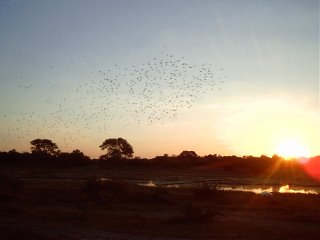
It's late on a Sunday morning and I'm watching these two hippos from across the Thamalakane River - about 300 metres down stream from the hotel. They have been eating the river grasses and wading along the far shore for the last half hour.
The 'far shore' is the best place to watch
hippos. They can be very territorial. Males like to mark their territory so that other hippos are aware and act appropriately. It is said that they kill more humans than any two other animals, in Africa. When the ears start to flick quickly and the mild, deep grunts become loud snorts - its time to move away.
Although hippos look fat and seem to have a smile on their face, they are all muscle and very serious. Top sped on the open malapo can be over 30 kilometres per hour. Reaching lengths of up to four metres, hippos will at times attack a boat twice their length.
When you see a group of hippos sleeping together on a river bank, it is hard to believe they can be so reactionary. Field glasses give you the freedom to be at a safe distance and see closely inside their mouth's when they yawn.
Do you want to work up a hunger for lunch? Tha 'Old Bridge' is just about two kilomentres up stream and a picturesque walk. When you stand in the middle of the bridge and look downstream, you are looking at the Hippo Pool. If you are lucky a group of hippos will we lounging on the banks.





